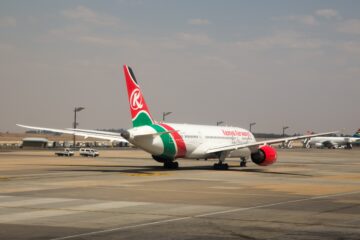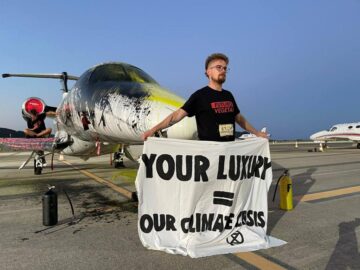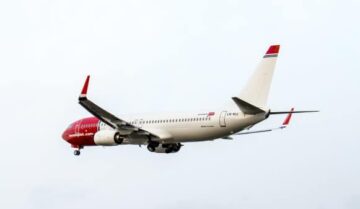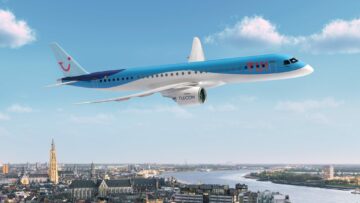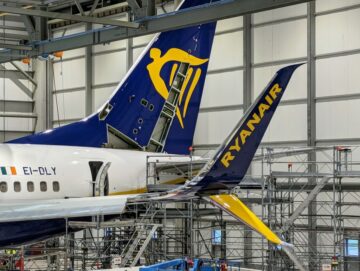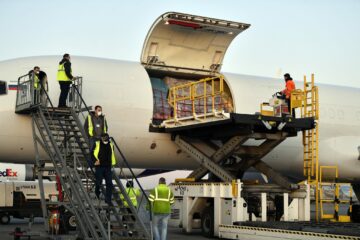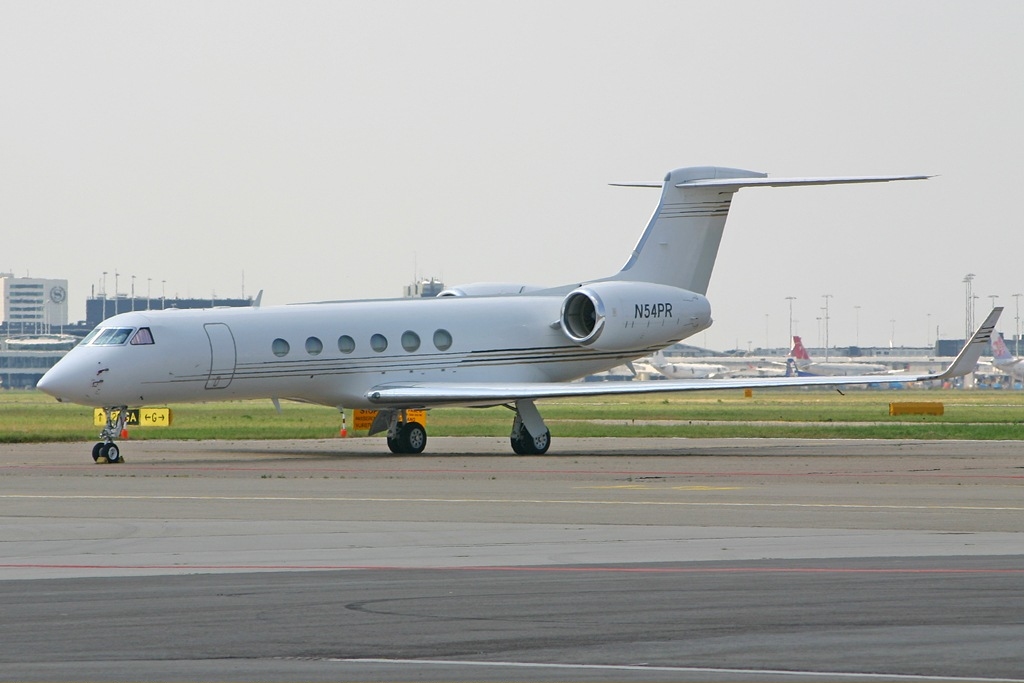
A new study commissioned by Greenpeace shows that the number of private jet flights in Europe increased by 64% last year, to a total of 572,806 flights. Of all these journeys, 55% were short or ultra-short flights of less than 750 km. Last year, 10,618 private jets took off in Belgium. The most common connection by private jet from Belgium is Brussels-London. Greenpeace calls for a ban on private jets.
The study, conducted by Dutch environmental consultancy CE Delft, found that the countries hosting the most private jet flights in Europe in 2022 are the UK, France and Germany. [1] The three most popular destinations for private jets in Europe are Nice, Paris and Geneva. After dropping sharply in 2020 with the pandemic, the number of private jet flights rebounded just thereafter. In 2021, despite the confinements which continued all over the world, the figures were already higher than those of 2019. In Belgium too, private jet flights are very popular.
Private jets in Belgium (2022)
In 2022, 10,618 private jet flights left Belgium, i.e. 52% more than in 2021.
These flights generated 41,000 tonnes of CO2 emissions, which is as much as the average annual emissions of 27,310 cars.
The Brussels-London route is the most popular, with 647 flights. Next come Brussels-Paris (545 flights) and Brussels-Geneva (407 flights).
The shortest connections are Kortrijk-Lille: 27.8 km (239 flights) and Liège-Maastricht: 37 km (62 flights). There were 204 flights between Brussels and Antwerp (40 km).
“This alarming increase in private jet flights is in complete contradiction with all the scientific data relating to the climate, which shows us that only the immediate reduction of greenhouse gas emissions can prevent us from a total catastrophe,” denounces Carine Thibaut, spokesperson for Greenpeace Belgium. “The IPCC report, released last week, shows more clearly than ever the need to urgently reduce our excessive consumption of fossil fuels. The ban on ultra-polluting and energy-guzzling private jets is obvious. Only a minority of the ultra-rich benefit from private jets. The rest of the population, its vast majority, will never set foot in a private jet. But nevertheless suffers from their greenhouse gas emissions, their toxic ultra-fine dust, their noise pollution…”.
Private jets are the most polluting mode of transport in the world per passenger-kilometre, and yet they are not subject to any regulation within the EU. The revised Community Emissions Trading Scheme (ETS), which enshrines the “polluter pays” principle and is at the heart of European climate policy to combat greenhouse gas emissions, largely excludes part private jets and other luxury modes of transport.
“It is outrageous that the EU is giving the ultra-rich a free pass to continue polluting at the expense of the planet. The EU and national governments must stop pandering to the aviation lobby and put an end to this luxury transport which places a heavy burden on society. It is high time for a zero-tolerance policy towards irresponsible luxury issuers and a ban on private jets. We expect our country to plead in favour of such a ban on the European scene and to put in place a dissuasive national policy, like our French neighbours,” concludes Carine Thibaut.
Elsewhere
Greenpeace also published of the Delft analysis for France, the most polluting country in Europe with 11% of the CO2 emissions by private jets. With the most striking example, Paris to Paris:
? 1er du classement : Paris -> Paris
? 12 min en voiture
? F-HTTO de TotalEnergies pic.twitter.com/Vd09kTLNT9— laviondebernard (@laviondebernard) March 28, 2023
The study also shows that more private jets took off from the UK than any other country in Europe in 2022.
[1] CE Delft’s analysis is based on data from the aeronautical analysis company Cirium. The study covers all private flights departing from and arriving in European countries over a three-year period (2020 – 2022). Flights are broken down by year, route and aircraft type. Some small aircraft with less than three seats were not included in the data because they are mainly used for leisure and not for business or private flights. In addition, flights to and from airports without an IATA code and flights arriving at the airport from which they departed were excluded. CO2 emissions for all flights were calculated using the Eurocontrol Small Emitters Tool.
Related articles
- SEO Powered Content & PR Distribution. Get Amplified Today.
- Platoblockchain. Web3 Metaverse Intelligence. Knowledge Amplified. Access Here.
- Source: https://www.aviation24.be/miscellaneous/greenpeace/record-number-of-private-jets-in-europe-and-belgium-used-even-for-very-short-distances-like-kortrijk-lille-27-8km/
- :is
- 000
- 1
- 10
- 2019
- 2020
- 2021
- 2022
- 28
- 8
- a
- addition
- After
- aircraft
- airport
- Airports
- All
- already
- analysis
- and
- annual
- ARE
- arriving
- articles
- AS
- At
- average
- aviation
- Ban
- based
- because
- Belgium
- benefit
- between
- Broken
- Brussels
- burden
- business
- by
- calculated
- Calls
- CAN
- cars
- clearly
- Climate
- co2
- co2 emissions
- code
- combat
- come
- Common
- community
- company
- complete
- conducted
- connection
- Connections
- consultancy
- consumption
- continue
- continued
- countries
- country
- covers
- data
- Despite
- destinations
- down
- Dropping
- Dust
- Dutch
- e
- Emissions
- environmental
- EU
- Europe
- European
- European Countries
- Even
- EVER
- example
- excluded
- expect
- expense
- Figures
- Flights
- Foot
- For
- fossil fuels
- found
- France
- Free
- French
- from
- fuels
- GAS
- generated
- Geneva
- Germany
- Giving
- Governments
- greenhouse gas
- Greenhouse gas emissions
- Greenpeace
- Heart
- heavy
- High
- higher
- hosting
- HTTPS
- i
- immediate
- in
- included
- Increase
- increased
- IT
- ITS
- Jets
- Journeys
- jpg
- largely
- Last
- Last Year
- like
- Lobby
- Luxury
- Majority
- minority
- Mode
- modes
- more
- most
- Most Popular
- National
- Need
- Nevertheless
- New
- next
- Noise
- number
- obvious
- of
- on
- Other
- pandemic
- paris
- part
- period
- Place
- Places
- planet
- plato
- Plato Data Intelligence
- PlatoData
- policy
- Popular
- population
- prevent
- principle
- private
- published
- put
- record
- reduce
- Regulation
- released
- report
- REST
- Route
- scene
- scheme
- set
- Short
- Shows
- small
- Society
- some
- spokesperson
- Stop
- Study
- subject
- such
- Suffers
- that
- The
- the UK
- the world
- their
- These
- three
- time
- to
- too
- tool
- Total
- towards
- Trading
- transport
- true
- Uk
- us
- Vast
- week
- which
- will
- with
- within
- without
- world
- year
- zephyrnet


